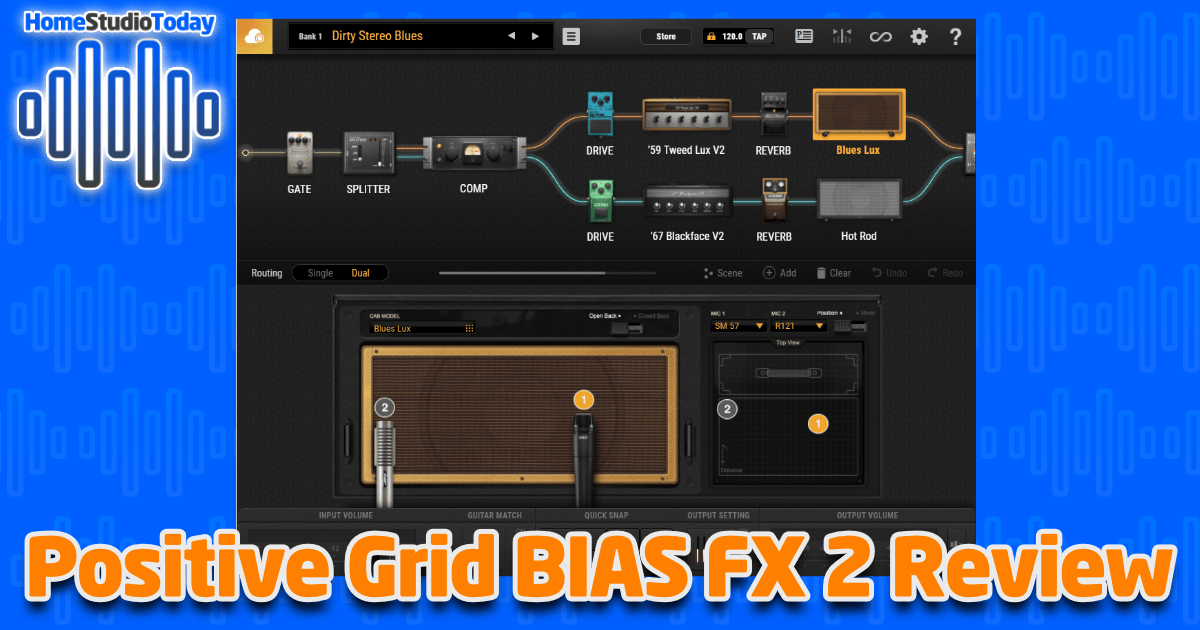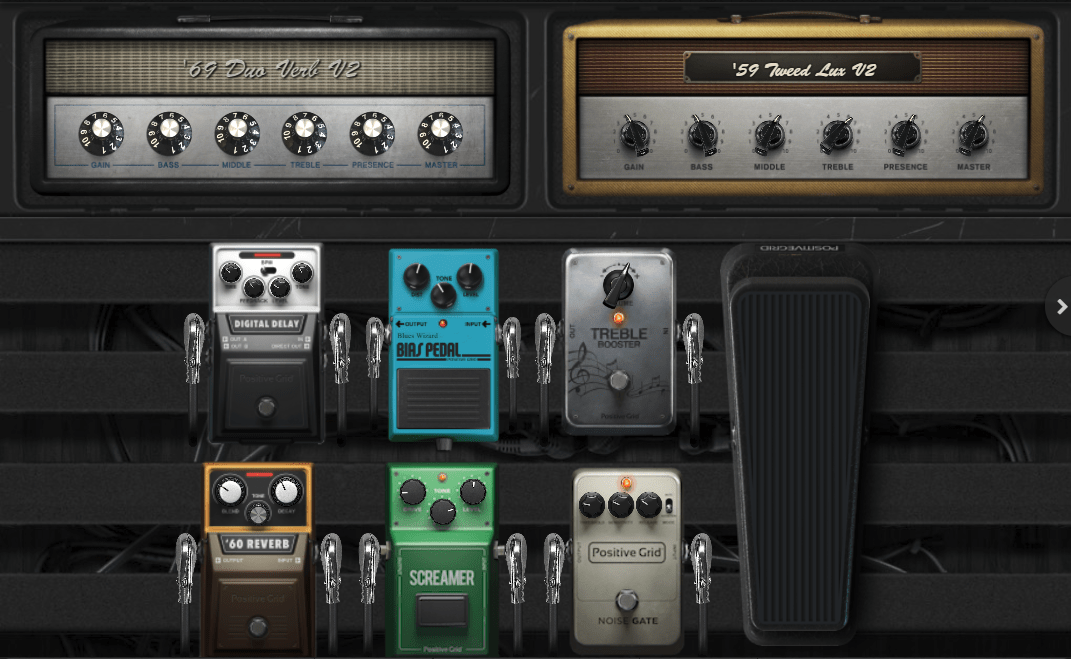If you enjoy this review and decide to grab the deal, please consider clicking through one of my links before you buy. I earn a small commission at no cost to you, which helps support this site and keep the reviews coming. Thanks!
Imagine there’s a room in your house chock full of nearly every major amp, speaker cab, effects pedal and microphone ever created. What would you pick to play through? Would you create an intricate signal path using a vintage tube compressor, wah, fuzz, and delay to recreate Jimi’s sound? Would you run a split setup with an authentic ’59 Tweed on your left and a ’67 Blackface on your right, each with its own separate effects chain, creating the ultimate dirty blues tone? Or would you do the same, except with a JCM800 and a 5150 and get crunchy? Would you use Celestion Greenbacks or a Mesa cab? Would you mic up with Royers, MD421s, or C414s?
Bringing this imaginary room full of gear to your DAW is the goal of BIAS FX 2, an guitar amp and effects simulator suite from Positive Grid. Today we’re going to put BIAS FX through its paces and get neck-deep in tone. Let’s get started.
Looks
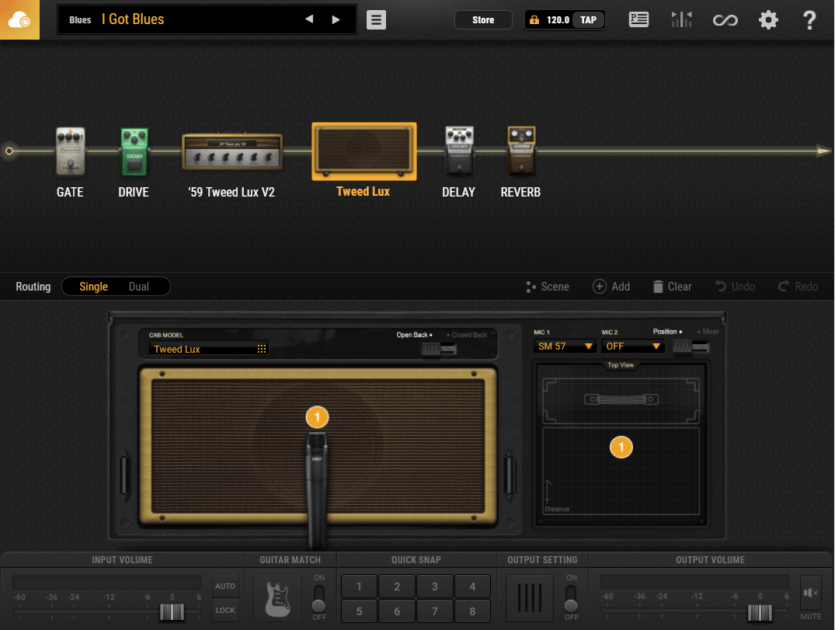
After the splash screen, BIAS FX 2 opens by default to the Routing screen, where you can customize your signal path through the myriad effects and amplifiers included with the plugin. Above the main screen is a menu bar, and below are volumes, output settings, preset Quick Snap and Guitar Match. Starting from the left, the top bar includes an icon for Positive Grid’s Tonecloud, a preset loader, a preset editor button, a link to the Positive Grid store, tempo controls, Pedalboard view toggle, Tuner, Looper, Settings menu and Help. The bottom bar includes input and output volumes, Guitar Match toggle, Quick Snap buttons for quickly loading favorite gear setups, and a global output settings menu and toggle.
Hitting the Pedalboard button in BIAS FX 2 takes you to a screen where you can quickly and easily modify the settings of the amps, pedals, and rackmount gear but can’t swap them out, perfect for changing settings on the fly in a performance situation. Clicking any of the pieces of gear in the Routing screen provides a zoomed-in view of the pedal, amp, or routing box where you can tweak its settings to your liking. Double-clicking gear opens a gear browser that allows you to change effects and amps. There are options for single or dual routing, pedal scenes, adding effects and amps, clearing the whole pedalboard to a default view, and undo/redo. Overall, it’s an attractive and well-laid-out plugin with an intuitive interface.

Features
In the interest of keeping this review to a readable length, I’m going to summarize the features in Positive Grid BIAS FX 2 the best I can in an effort not to leave anything out. (This plugin is really that immense.) We’ll start at the top left and work our way across and down:
Tonecloud and Presets
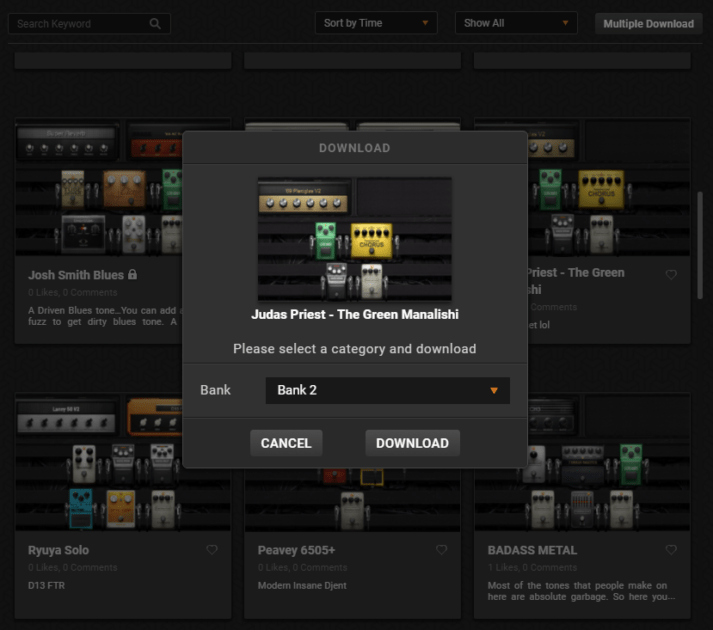
Positive Grid BIAS FX 2‘s preset library includes some cool starting points; the ‘American Dream’ preset that the plugin initially loads to, for example, is a lush, whooshing chorus, delay, and reverb with split vintage amps and cabs that had me noodling and playing with settings for quite literally an hour when I first bought it. Other favorites presets of mine include ‘I’ve Got Blues’ and ‘British Dirt.’
BIAS FX 2‘s Tonecloud is the real prize, however, as it opens this plugin up to the innovation and creativity of the entire world. Tonecloud allows you to download other users’ setups as well as sharing your own. There are thousands of presets to choose from in numerous categories, making the tone possibilities quite endless when paired with the enormous gear library available in this plugin.
Tempo, Tuner, and Looper
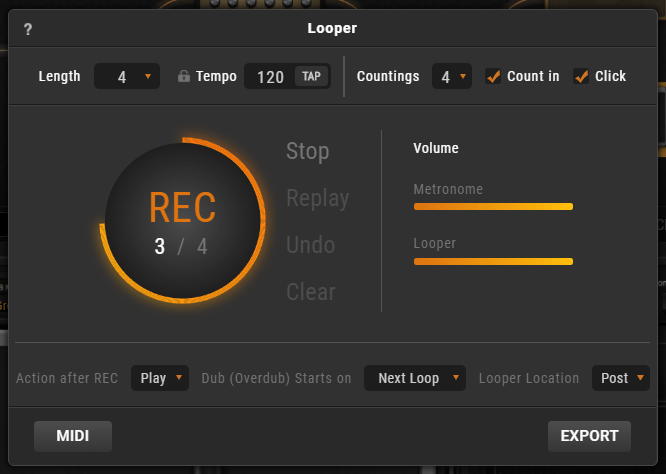
The Tempo control in BIAS FX 2 is pretty standard and includes a host DAW tempo lock/unlock and a tap tempo button. The tuner is muted by default and features a mute toggle and frequency controls for setting ‘A’ in a range between 430 and 445.
I have something to admit… In three decades of playing guitar, I’ve never used a looper pedal before. By the time they got popular I was already recording on PC and didn’t really see the benefit of using one live. Because of that, I can’t really speak to whether the Looper in BIAS FX 2 is comparatively good or how it would be in a performance situation as compared to an outboard pedal.
What I can say, however, is that I found the Looper very useful for creating song ideas in short order. Within just a few loops I was able to lay down a fun new idea for a song, and I wasn’t even trying. Using the export function, I exported my idea to a WAV file to playback later and build a new song around.
Routing View
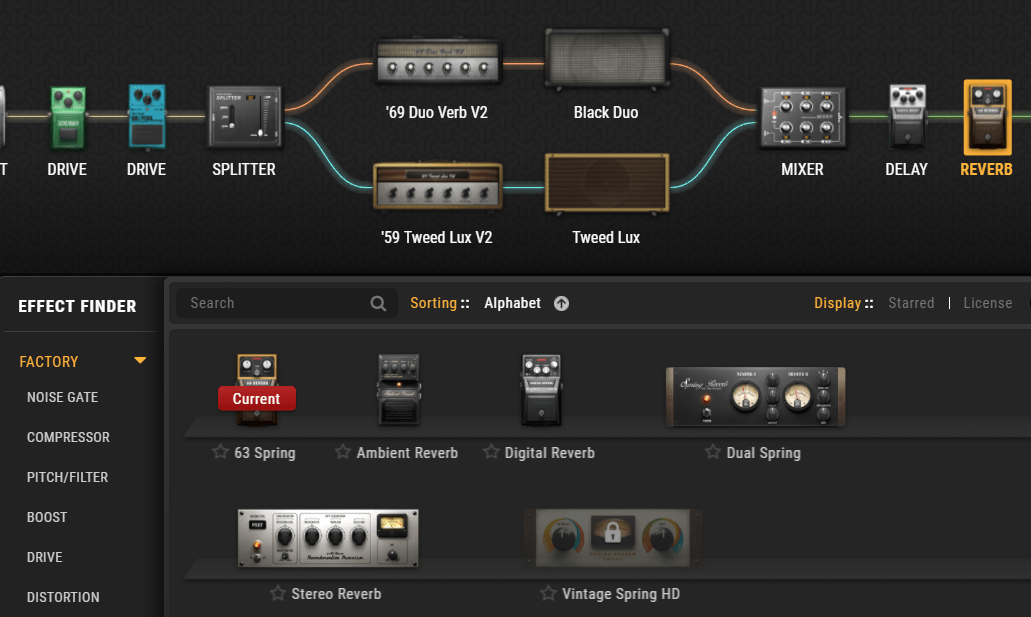
The Routing view is where I fell in love with BIAS FX 2. Here you can quickly and easily swap gear in and out, set up complicated signal paths, and using the Scene control you can A/B test settings to find your favorite combinations. As I mentioned in the intro, there is an absolutely immense library of amps, cabs, and effects bundled with this plugin, and all of those are routable into dual-amp configurations for awesome-sounding stereo effects. Any of these pedals or amps individually could be its own plugin, so to have all of them in one place is astounding.
Another awesome feature in BIAS FX 2 is the ability to import any amps that you create in its sister program, BIAS AMP 2, which is an amp customizer and IR loader program. So imagine creating your very own guitar amplifier with details down to the tubes, the transformer, and the speakers, then importing that into the immense gear suite available in BIAS FX 2. This one feature really pushes BIAS FX 2 over the cliff in terms of usability and value for toneheads.
I could gush about this plugin’s range for days, but instead, I’ll share the list of gear available to choose from here. (Positive Grid adds new gear to BIAS FX 2 fairly often; this list was last refreshed 11-7-2020.)
| Edition | Modeled Amps ( * = Positive Grid Originals ) |
| Standard | Low Gain: Fender Blackface Super Reverb, Fender Deluxe Reverb, Fender Twin Reverb, Fender Vibro Champ Silverface, Gretsch 6156 Playboy, Roland JC120, Vox AC30. Crunch: Hiwatt DR103, Marshall JCM800, Marshall Super Lead 100, Orange AD30, Overdriven Fender Deluxe Reverb, Overdriven Marshall JTM45, Two Rock Studio Pro 50. High Gain: Diezel VH4, Engl Invader 100, H&K Switch Blade lead channel, Mesa Boogie Mark V, Mesa Boogie Triple Rectifier, Peavey 5150, Soldano SP77 Acoustic: Acoustic Sim V2*, Flat Acoustic *, Keyboard Amp*. Bass: Ampeg B-15, Ampeg SVT Blue Line, Gallien Krueger 700RB-II, Gallien-Krueger 800RB, Hiwatt DR201, Marshall Super Bass, Mesa Boogie Subway D-800. |
| Professional | All Standard amps plus: Low Gain: Dr.Z PhD, Matchless DC30, 67 Dumble Clean*, Clean Master V2*, Solo Star*. Crunch: Marshall Silver Jubilee, Marshall Super 100JH, Laney GH50R, Orange Rockverb 50, Divided by 13 FTR37, Fender SuperSonic Twin, Paul Reed Smith Archon 100, Grid Crunch V2*, Modded Plexi V2*, Pushed Tweed V2*. High Gain: VHT Pitbull, Bogner Ecstasy 101, Engl Fireball 100, Marshall AFD100 Slash Signature, Mesa Boogie Mark IIc+, Randall Satan, Friedman BE100, Marshall 2203KK Kerry King Signature, High Gain EL34 V2*. Acoustic: Acoustic Amp V2*, Fat Acoustic V2*. Bass: Acoustic 360, Fender Super Bassman, Sunn 300T. |
| Elite | All Professional amps plus: Low Gain: Dr.Z Z Wreck, Dumble ODS 50, Fender Super Amp, Fender Super Reverb, Fuchs Overdrive Supreme, Marshall Bluesbreaker, Marshall JTM45 Clean, Orange AD 30, Vox AC30 Handwired Crunch: Dr.Z Maz18, Dr.Z Z-Lux, Fender Deluxe Reverb w/ TS808, Fender The Twin CH2, Fender Vibroverb w/ TS808, Guyatone GA930, Marshall JMP Plexi 1968, Mesa Boogie Lonestar CH2, Teisco Checkmate20, Vox AC30 Handwired Overdriven. High Gain: Diezel Hargen, ENGL RB100, Framus Cobra, Marshall JMP Plexi 1979, Marshall YJM100 Signature, Matchless Lightning, Mesa Boogie JP-2C, Mesa Boogie Mark IV, Mesa Boogie Roadking, Mesa Boogie Triple Rectifier CH3, Peavey 6505, Randall RD45, Randall V2, Two Rock Bi-Oynx Lead CH. Bass: Aguilar Tone Hammer 500, Ampeg SVT 400T, Eden WTP600, H5000, Markbass TTE 500, Mini Mark II, Trace Elliot V Type 5001. |
| Edition | Modeled Effects |
| Standard | Noise Gate; Compressor, Red Comp, Blue Comp, Tube Comp; Treble Booster, Booster, BIAS Preamp, Power Booster; 808OD, OverdrivePro; DistortionX, DSONE, VintageFuzz, Mouse, Metaltone Mod; EQ4, EQ6, EQ10, Volume; Auto Wah, Cry Wah, Octaver; Chorus, Flanger, Flanger Pro, Orange Phaser, Phaser Pro, Stereo Chorus, Tremolo, Vibrato, Rotary, Vintage Rotary; Delay, Tape Delay, Slapback Delay, Digital Ambient, Dark Memory, Hendrix Delay; Digital Reverb, 63 Spring Reverb, Stereo Reverb. |
| Professional | All Standard effects plus: Noise Reduction, Noise Filter; Opto Comp, 4K Comp, Studio Comp, Multi Comp HD; S-Booster, Tube Boost; Tube Driver, Clone Drive, Matched Tube, Dumble Clean, Blues Wizard, Sweet OD, Vintage Overdrive; SAB Driver, Fuzz Arsenal, Guitar Muff, Preamp, Thrash Master, PainKiller, Hell Metal, Bloodline, Purple Chaos, JB Fuzz, Super Fuzz, Tube Master, British Crunch, Heavy Fuzz, Distortion Plus; Studio EQ; Poly Octaver; Mu-Tron, Pitch Shifter, Wah HD; Chorus One, Stripe Flanger, Classic Vibe, Analog Phaser, Ring Mod, Dual Phaser, Cloner, Tremulator, Jet Flange, Slow Attack, QuickQuak, Magic Vibe, PhasePan, Broken Vibe, AutoSwell, PhaseTrem, Vintage Trem, Lush Ensemble, Tri-Chorus HD; Analog Delay, Echotape, Deluxe Delay, Ping Pong, Reverse Delay, Little Phased Analog Delay, Dark Blue Echo, Edge Dot Delay, Tremolo’d Delay, Smooth Analog, Fat Phaser Tape, FireJet Delay, Analog Harmony, Another Moon, Mega-Tap HD; Ambient Reverb, Dual Spring. (Professional edition also adds MIDI mapping capability for using external MIDI devices to control amp and effects settings.) |
| Elite | All Professional effects plus: Advance Comp HD, Fuzz Modeler, Harmony Modeler, Les Rotary HD, EchoreX HD, Time Modeler, Vintage Spring HD, |
| Speaker Configuration | Modeled Speaker Cabs and Mics |
| 1×12 | Black Lux, Blues Lux, C-12K, Hot Rod, Solo Star, Tweed Lux, Vibro Lux. |
| 1×18 | Big Bass. |
| 2×10 | Bass CX-10, Bass Pro, Bass Superb Duo. |
| 2×12 | Alnico Blue, Bass NEO, Black Duo, British 30, British 900, Chrome, Green25, Hiway Fane, Jazz Clean, Orange, Vibro. |
| 4×10 | Bass GK, P10Q, Tweed Bass. |
| 4×12 | 1965A, British Carbon, British G12V, Celestion T-75s, Celesion V-30s, ENG, Green 25s, Hiway 4123, Legend, Metal V, OR V-30s, Rectifier, Thrasher, Treadplate. |
| Others | Acoustic, Acoustic Sim, Bass Blue (6×10), Bass Superb Six (6×10), Bass Super (8×10), Bass Superb Eight (8×10). |
| Mics | SM57, MD421, R121, C414. |
| Edition | Guitar Match Models |
| Standard | Gibson Les Paul Custom ’57 Goldtop Reissue, Fender Stratocaster Heritage Reissue, PRS Custom 22, Fender Strat Yngwie Malmsteen Signature. |
| Professional | Fender Telecaster ’52 Reissue, Gibson Custom ES-335 ‘Dot’ Custom Classic, Fender Jazzmaster Pro Heritage Reissue, Gibson Flying V Randy Rhoads Signature. |
| Elite | Gretsch Chet Atkins Country Gentleman, Fender Stratocaster Wildwood 10, Ernie Ball Music Man John Petrucci Signature VI, Fender Stratocaster John Mayer Signature, Fender Jazzmaster vintage, Fender Stratocaster Rosewood vintage, Fender Telecaster with Charlie Christian pickups, Duesenberg Starplayer TV, Gibson ES-335 50th Anniversary, Paul Reed Smith Custom 24, ESP Horizon, ESP Original Eclipse. |
Pedalboard View
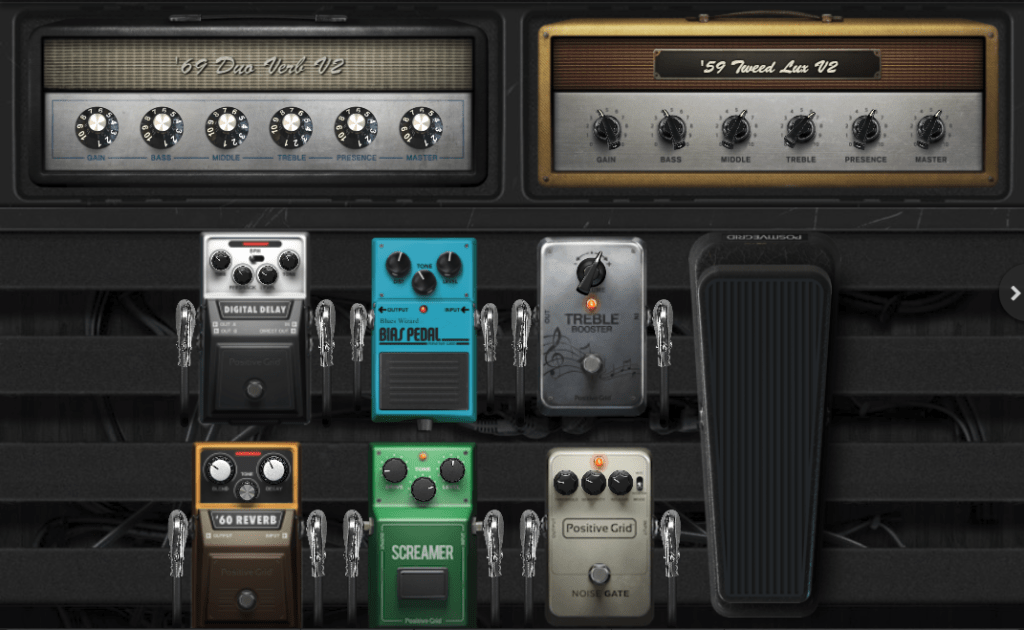
Once you’ve customized your ultimate dream presets in BIAS FX 2, the Pedalboard feature allows you a simple top-down view of your entire effects chain and amp stack for control on the fly. This is especially great for tweaking settings for the entire board at once after picking out your desired gear in the Routing screen. I could also see how this would also be useful for a live rig; using the Quick Snap buttons to set go-to favorites between songs would be far easier and faster than setting up complicated A/B routing before every gig.
Guitar Match and Output Settings
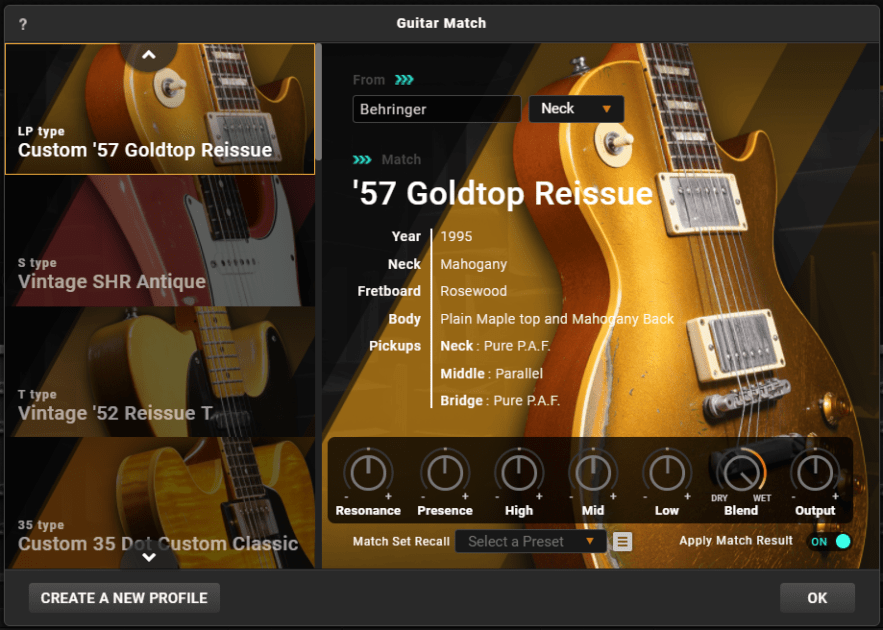
I have to admit that I was expecting Guitar Match to be cheesy, but in reality it is quite the opposite. My test guitar was my cheap Strat-style copy with three single-coils that has become my go-to when I need to get an idea in the can and don’t care as much about the tone. I went through the process of creating a profile for the neck pickup, turned Guitar Match on and picked ‘Custom ’57 Goldtop Reissue’ and was suddenly hearing the sultry low-end of a humbucker in the neck position of a Les Paul instead of the twang of my Strat copy. Clicking through the other options I could hear differences in the tones, both subtle and obvious.
The Output Settings control takes all of the functionality I mentioned thus far and adds a new angle. You can independently enable or disable the Pre Amp, Tone Stack, Power Amp, or Cab portions of the model, as well as add global EQ and resonance. Definitely an interesting and cool feature for the real gear-heads out there that will chain this plugin along with a host of others for even further customization.

Usability
Positive Grid did an excellent job of not only packing in all of the gear listed above but also of creating a highly usable and intuitive interface for BIAS FX 2. Everything on the Routing screen can be clicked and dragged to rearrange in moments, and every piece of gear can be right-clicked to bring up context menus. Replacing, disabling or removing gear takes just a few clicks, and tweaking gear settings is also only a click away. It really was designed with the player in mind.
One important thing to note is that this much functionality comes at a cost: BIAS FX 2 uses as much as 6% of the CPU on the quad-core, overclocked gaming PC that functions as my DAW machine, and each additional track uses another 3-4%. If you’re using an older machine you may consider using the dual-routing (stereo) functions on a single track instead of double- or triple- tracking your guitars, especially in a larger session. I had seven instances of BIAS FX 2 open during one session (three double-tracked guitars plus bass) and definitely noticed the toll it was taking on my PC’s responsiveness. I even experienced a few crashes during the mixing and mastering processes when all of my metering and mastering plugins were also enabled. This is the only drawback of the plugin that I found in months of experimentation, but feel that it should still retain a full five stars in usability due to the largesse of features that Positive Grid managed to fit into less than 6% CPU on my DAW machine.

Hear it in Action
Because there is so much to hear in BIAS FX 2, this review is going to include a few more samples than in most of my reviews. For these samples, I recorded one four-bar loop, added BIAS FX 2 to the guitar track and a mastering limiter to the master buss, then changed nothing but the presets to create the samples below. First up is ‘American Dream,’ followed by two presets I created myself called ‘Dirty Stereo Crunch’ – a 5150/JCM800 stereo pair with distortion – and ‘Dirty Stereo Blues’ – a Tweed Lux/Blackface pair with overdrive. The fourth sample is also ‘Dirty Stereo Blues,’ but with the Guitar Match set to ’57 Goldtop Reissue. The final sample is with BIAS FX 2 in bypass for reference. Here they all are:
Positive Grid Bias FX 2 Review – The Bottom Line
When I was a teenager there was a small music store near my house where I would hang out nearly every weekend and play with all the gear for hours at a time. I’d experiment with combinations of guitars, amps, and effects, and dream about having access to all that gear. It was a visceral feeling of excitement and wonder every time I’d walk into the store, like a young adult playground. When a cool piece of gear would come in, a guy working there would always say “you should totally check this out, it has tone for days!”
“Tone for days” is the best way I can describe Positive Grid BIAS FX 2. Having BIAS FX 2 in my arsenal has changed my workflow completely and restored that visceral feeling that I used to get all those years ago every time I load up my DAW. Normally plugin reviews take me a few days to a week or two, however, this review has taken me considerably longer due to the sheer breadth of Positive Grid BIAS FX 2‘s features. It was honestly a little overwhelming trying to capture the whole thing in a few thousand words, as I feel I could have picked one single piece of the plugin and written a whole review on that alone.
Because of that incredible breadth, compared to any other guitar plugin I’ve used BIAS FX 2 is at least equal if not far surpassing the competition in terms of value. I definitely recommend that anyone who loves the guitar at least try it out and see what all the fuss is about.

In conclusion, I give Positive Grid BIAS FX 2 a wholehearted recommendation, five stars, and a kudos to the developer in restoring that long-sought-after feeling of wonderment in an affordable all-in-one plugin.

Amp and effects simulation suite with an incredible amount of gear, plus online features to share presets. Easily the best value in modern DI recording.

